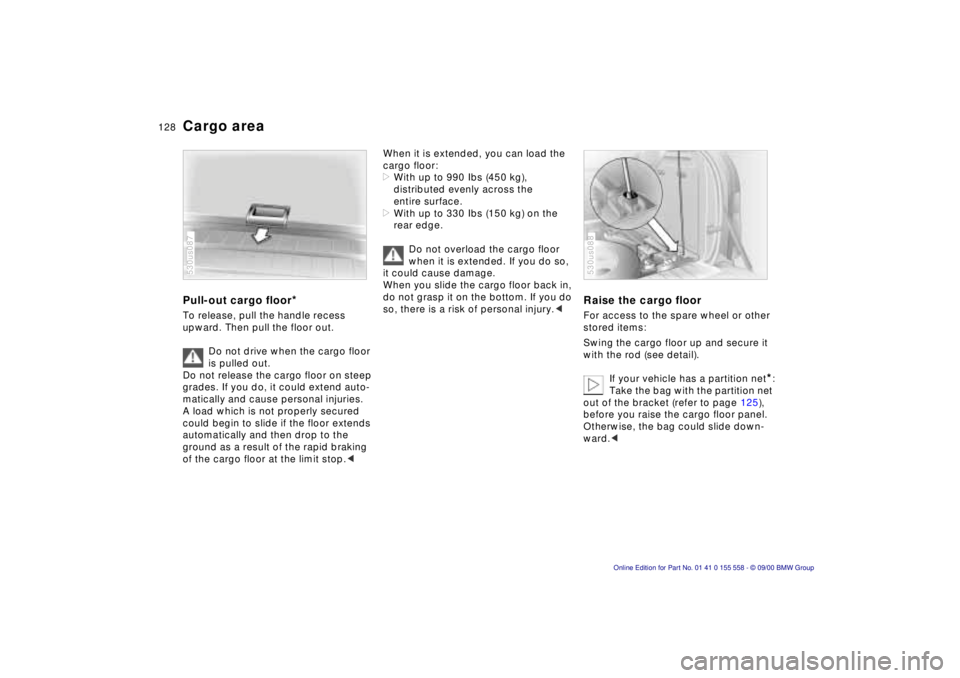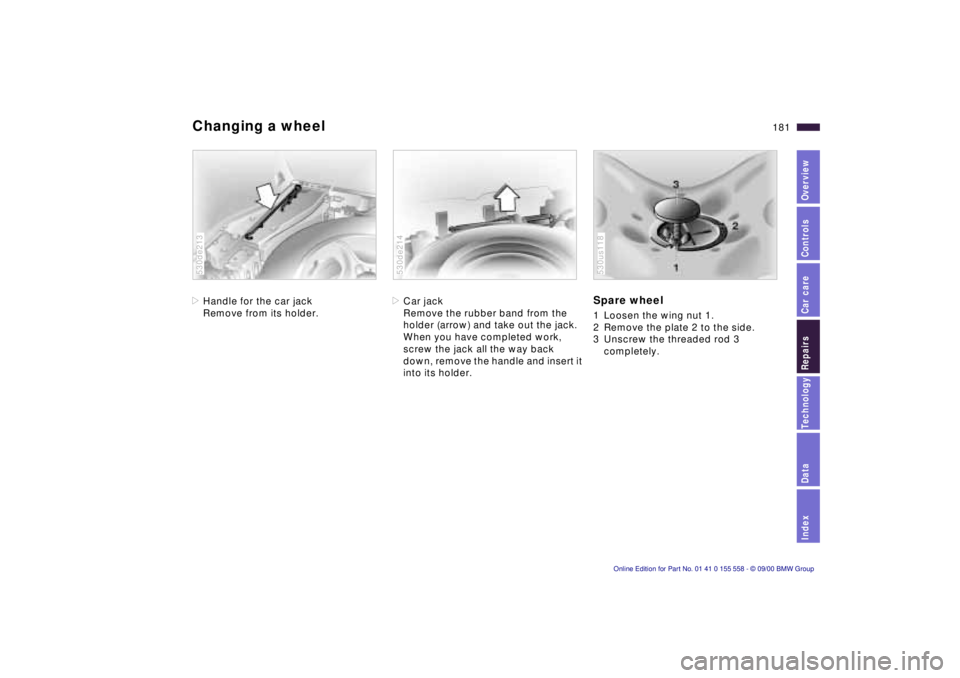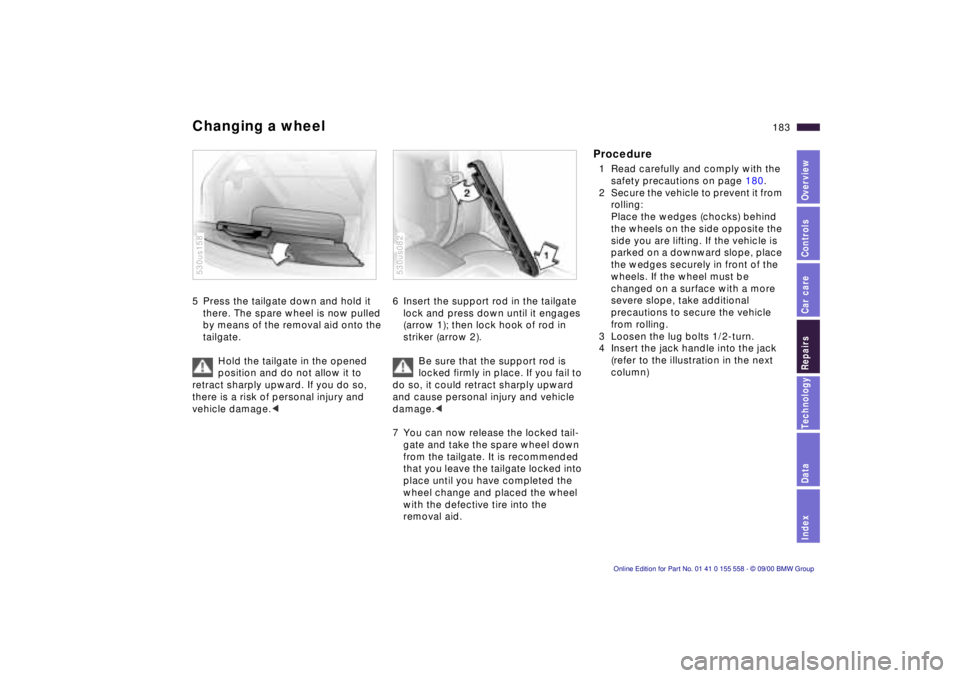2001 BMW X5 3.0I spare wheel
[x] Cancel search: spare wheelPage 30 of 223

30nFuel specifications Tire inflation pressure
The engine uses lead-free gasoline
only.
Required fuel:
>Premium Unleaded Gasoline,
min. 91 AKI.
AKI = Anti Knock Index
Do not use leaded fuels. The use
of leaded fuels will cause perma-
nent damage to the system's oxygen
sensor and the catalytic converter. <
You will find tire inflation pressures on
the inside door pillar.
Check tire pressures
All pressure specifications are indicated
in psi (kilopascal) for tires at ambient
temperature (refer also to the next
page).
530us009
Check tire inflation pressures
regularly — at least every two
weeks and before beginning a longer
trip. Incorrect tire pressure can other-
wise lead to tire damage and accidents.
Check the tire inflation pressure of the
spare wheel. Inflate the spare tire to
the highest inflation of any tire on your
vehicle. <
Comply with tire approval
specifications
The inflation pressures in the table
apply to tires from BMW-approved
manufacturers. Your BMW center is
familiar with these pressures. Higher
pressures may be specified for tires
from other manufacturers. You will find
a list of approved tires beginning on
page 150.
Your vehicle is equipped with tires that
not only meet US standards, but also
European standards. We recommend
the exclusive use of BMW-approved
tires.
Page 127 of 223

IndexDataTechnologyRepairsCar careControlsOverview
127n
Cargo areaFloor coverTo access the spare wheel.
To release: press the recess in the
handle (arrow) and raise the cover with
the handle.530us085
Fold the floor cover upLift up the black retainer on the lower
side of the panel and hook it into the
upper frame of the liftgate cutout.
Before you fold the floor cover down,
return the retainer to its original posi-
tion.530us086
Power outlets When you fold the cover cap up, you
have access to additional power
outlets.
You can use the power outlets for flash-
lights, car vacuum cleaners or other
automotive appliances with up to
approx. 200 watts at 12 volts. Avoid
damage to the socket caused by
inserting plugs of a different shape or
size.
Refer also to page 121. 530us084
Page 128 of 223

128n
Cargo areaPull-out cargo floor
*
To release, pull the handle recess
upward. Then pull the floor out.
Do not drive when the cargo floor
is pulled out.
Do not release the cargo floor on steep
grades. If you do, it could extend auto-
matically and cause personal injuries.
A load which is not properly secured
could begin to slide if the floor extends
automatically and then drop to the
ground as a result of the rapid braking
of the cargo floor at the limit stop.< 530us087
When it is extended, you can load the
cargo floor:
>With up to 990 Ibs (450 kg),
distributed evenly across the
entire surface.
>With up to 330 Ibs (150 kg) on the
rear edge.
Do not overload the cargo floor
when it is extended. If you do so,
it could cause damage.
When you slide the cargo floor back in,
do not grasp it on the bottom. If you do
so, there is a risk of personal injury.<
Raise the cargo floorFor access to the spare wheel or other
stored items:
Swing the cargo floor up and secure it
with the rod (see detail).
If your vehicle has a partition net
*:
Take the bag with the partition net
out of the bracket (refer to page 125),
before you raise the cargo floor panel.
Otherwise, the bag could slide down-
ward.<
530us088
Page 145 of 223

IndexDataTechnologyRepairsCar careControlsOverview
145n
Information for your safetyThe factory-approved radial tires are
matched to the vehicle and have been
selected to provide optimum safety and
driving comfort on your vehicle.
It is not merely the tire's service life, but
also driving comfort and – above all else
– driving safety which depend on the
condition of the tires and the mainte-
nance of the specified tire pressure.
Incorrect inflation pressure is a frequent
cause of tire damage. It also signifi-
cantly influences the roadholding ability
of your BMW.
Check tire inflation pressures –
including the spare wheel – regu-
larly (refer to page 30), at least every
two weeks and before beginning a
longer trip. If this is not done, incorrect
tire pressures can cause driving insta-
bility and tire damage, ultimately
resulting in an accident.<
Tire tread – Tire damageInspect your tires frequently for tread
wear, signs of damage and for foreign
objects lodged in the tread. Check the
tread pattern depth.
Tread pattern depth should not be
allowed to go below 0.12 in (3 mm),
even though the legally specified
minimum tread pattern depth is only
0.063 in (1.6 mm). At a tread pattern
depth of 0.063 in (1.6 mm), tread wear
indicators (arrow) in the tread-groove
base indicate that the legally-permis-
sible wear limit has been reached.
Below 0.12 in (3 mm) tread pattern
depth, there is an increased risk of
aquaplaning, even at relatively
moderate speeds and with only small
amounts of water on the road. 390de331
Do not drive on a deflated (flat)
tire. A flat tire greatly impairs
steering and braking response, and can
lead to complete loss of control over
the vehicle.
Avoid overloading the vehicle so that
the permitted load on the tires is not
exceeded. Overloading leads to over-
heating and causes damage inside the
tires. The ultimate result can assume
the form of a sudden air loss.
Unusual vibrations encountered during
normal vehicle operation can indicate
flat tire or some other vehicle defect, as
can variations in normal vehicle
response, such as a pronounced
tendency to pull to the left or right.
Should this occur, respond by immedi-
ately reducing your speed and carefully
proceeding to the nearest BMW center
or professional tire center, or having the
vehicle towed in to have it and its tires
inspected.
Tire damage (up to and including blow-
outs) can endanger the lives of both the
vehicle occupants and other road
users.<
Tire inflation pressure Tire condition
Page 180 of 223

180n
Changing a wheel
Safety measures in the event of a
flat tire or wheel change: stop the
vehicle as far as possible from passing
traffic. Park on a firm, flat, surface.
Switch on the hazard warning flashers.
Turn the steering wheel to the straight-
ahead position, remove the key and
engage the steering lock. Shift into 1st or
reverse (selector lever in "Park" with
automatic transmission) and engage the
parking brake. All passengers should be
outside the vehicle and well away from
your immediate working area (behind a
guardrail, for instance). If a warning
triangle or portable hazard warning lamp
is required, set it up on the roadside at
an appropriate distance from the rear of
the vehicle. Comply with all safety guide-
lines and regulations. Change the wheel
only on a level, firm surface which is not
slippery. Avoid jacking the vehicle up on
a soft or slippery surface (snow, ice, very
smooth surfaces, etc.), since it could
slide sideways. Position the jack on a
firm support surface. Do not place
wooden blocks or similar objects under
the jack. If this is done, the jack might not
be able to reach its full support capacity
because of the limited height. Do not lie
under the vehicle or start the engine
when the vehicle is supported by the
jack. Failure to comply with this creates a
risk of fatal injury.<
What you will need In order to avoid rattling noises later,
note the position of the tools when you
remove them and return them to their
original position when you are through
using them.
>Two wedges (wheel chocks)
Open the liftgate and tailgate.
In the cargo area, fold up the floor
cover or pull-out cargo floor (refer to
page 127 or 128).
Take out the wedges (arrow) next to
the spare wheel. 530us117
>Lug wrench
Is located next to the spare wheel. 530us120
Page 181 of 223

IndexDataTechnologyRepairsCar careControlsOverview
181n
Changing a wheel>Handle for the car jack
Remove from its holder. 530de213
>Car jack
Remove the rubber band from the
holder (arrow) and take out the jack.
When you have completed work,
screw the jack all the way back
down, remove the handle and insert it
into its holder. 530de214
Spare wheel1 Loosen the wing nut 1.
2 Remove the plate 2 to the side.
3 Unscrew the threaded rod 3
completely. 530us118
Page 182 of 223

182n
Changing a wheelRemoval aid for the spare wheelBy using this device, you do not have to
lift the spare wheel out of the recess by
hand.
Its task is to help you to move the wheel
onto the tailgate, from where you can
easily lift it off.
1 Close the tailgate again.
2 Grasp the handle of the removal aid
behind the spare wheel with both
hands and pull upward over the
tailgate (arrow).530us155
3 Hook both buckles into the latch of
the tailgate (arrow); the tailgate is
released.530us156
4 Remove the support rod from the
bracket.530us080
Page 183 of 223

IndexDataTechnologyRepairsCar careControlsOverview
183n
Changing a wheel5 Press the tailgate down and hold it
there. The spare wheel is now pulled
by means of the removal aid onto the
tailgate.
Hold the tailgate in the opened
position and do not allow it to
retract sharply upward. If you do so,
there is a risk of personal injury and
vehicle damage.< 530us158
6 Insert the support rod in the tailgate
lock and press down until it engages
(arrow 1); then lock hook of rod in
striker (arrow 2).
Be sure that the support rod is
locked firmly in place. If you fail to
do so, it could retract sharply upward
and cause personal injury and vehicle
damage.<
7 You can now release the locked tail-
gate and take the spare wheel down
from the tailgate. It is recommended
that you leave the tailgate locked into
place until you have completed the
wheel change and placed the wheel
with the defective tire into the
removal aid.530us082
Procedure1 Read carefully and comply with the
safety precautions on page 180.
2 Secure the vehicle to prevent it from
rolling:
Place the wedges (chocks) behind
the wheels on the side opposite the
side you are lifting. If the vehicle is
parked on a downward slope, place
the wedges securely in front of the
wheels. If the wheel must be
changed on a surface with a more
severe slope, take additional
precautions to secure the vehicle
from rolling.
3 Loosen the lug bolts 1/2-turn.
4 Insert the jack handle into the jack
(refer to the illustration in the next
column)